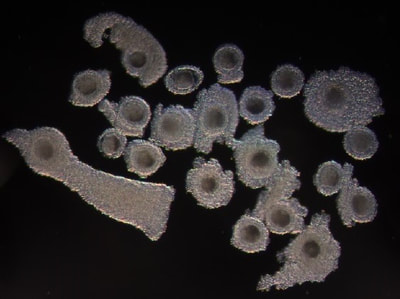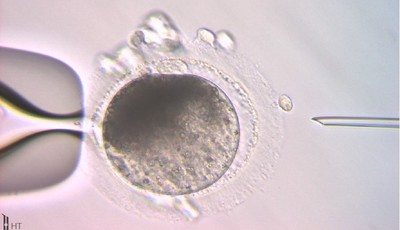Intracytoplasmic Sperm Injection (ICSI)
is a procedure that involves injection of a single sperm cell into the oocyte (egg). The technology is indicated for mares that have not produced foals in any other way, or ovary harvest from mares that are deceased or when using poorly performing semen or when semen is of limited quantity as in the case of deceased stallions. However, the in vitro embryo production system has improved and in the majority of the cases is more efficient that traditional embryo recovery after breeding the donor mare. We have performed thousands of ICSI cycles and produced over one thousand embryos since 2008. Year after year, we engage in research and clinical trials to improve pregnancy rates with our ultimate goal of live healthy foals. This technology, although not as common as conventional embryo transfer, has now reached a level of consistency accepted in the equine industry and provides a way for those once-in-a-lifetime mares to continue producing legendary horses. Currently we have collaborations with Alamo Pintado Equine Medical Center, Los Olivos CA, The Equine Center, San Luis Obispo, CA, Varian Equestrian, Arroyo Grande, CA and Coastal Equine Ranch, San Luis Obispo, CA
The Process:
Transvaginal Follicular Aspiration/Ovum Pick Up (OPU):
Oocytes (eggs) are collected from follicles in the ovaries by retrieval by ultrasound guide. In our experience, the average recovery rate is about 90% per dominant follicle and 75% for subordinate follicles per cycle. We also offer follicular aspiration of pregnant mares.
ICSI:
A single morphological normal sperm cell from fresh, cooled, or frozen semen is introduced into the oocyte using a micro injection pipette and micromanipulator system. An average of 70% of the injected eggs cleave (divide).
In Vitro Culture:
After ICSI the injected oocytes are placed in culture medium in a Time-Lapse incubator until day 6-9. An average of 1.8 transferable embryos are obtained after each mare collection. At this point the embryos (blastocysts) are non-surgically transferred into recipient mares or in some cases (usually when semen is the issue) to the donor mare. The pregnancy rate is around 75% at day 60, though varies depending on the donor mare's age and quality of the semen. In some cases, multiple embryos and pregnancies are achieved on the first try; in others, it may take several. For problem mares, try to select the most fertile semen choice, and if ICSI is required for the semen choice, choose younger, fertile mares.
Embryo Vitrification (freezing):
Resulting embryos can also be frozen via a procedure called vitrification for later transfer depending on the client's needs, market values and recipient availability. Expect a 5-10% decrease in pregnancy rates compared to transfer of fresh embryos.
is a procedure that involves injection of a single sperm cell into the oocyte (egg). The technology is indicated for mares that have not produced foals in any other way, or ovary harvest from mares that are deceased or when using poorly performing semen or when semen is of limited quantity as in the case of deceased stallions. However, the in vitro embryo production system has improved and in the majority of the cases is more efficient that traditional embryo recovery after breeding the donor mare. We have performed thousands of ICSI cycles and produced over one thousand embryos since 2008. Year after year, we engage in research and clinical trials to improve pregnancy rates with our ultimate goal of live healthy foals. This technology, although not as common as conventional embryo transfer, has now reached a level of consistency accepted in the equine industry and provides a way for those once-in-a-lifetime mares to continue producing legendary horses. Currently we have collaborations with Alamo Pintado Equine Medical Center, Los Olivos CA, The Equine Center, San Luis Obispo, CA, Varian Equestrian, Arroyo Grande, CA and Coastal Equine Ranch, San Luis Obispo, CA
The Process:
Transvaginal Follicular Aspiration/Ovum Pick Up (OPU):
Oocytes (eggs) are collected from follicles in the ovaries by retrieval by ultrasound guide. In our experience, the average recovery rate is about 90% per dominant follicle and 75% for subordinate follicles per cycle. We also offer follicular aspiration of pregnant mares.
ICSI:
A single morphological normal sperm cell from fresh, cooled, or frozen semen is introduced into the oocyte using a micro injection pipette and micromanipulator system. An average of 70% of the injected eggs cleave (divide).
In Vitro Culture:
After ICSI the injected oocytes are placed in culture medium in a Time-Lapse incubator until day 6-9. An average of 1.8 transferable embryos are obtained after each mare collection. At this point the embryos (blastocysts) are non-surgically transferred into recipient mares or in some cases (usually when semen is the issue) to the donor mare. The pregnancy rate is around 75% at day 60, though varies depending on the donor mare's age and quality of the semen. In some cases, multiple embryos and pregnancies are achieved on the first try; in others, it may take several. For problem mares, try to select the most fertile semen choice, and if ICSI is required for the semen choice, choose younger, fertile mares.
Embryo Vitrification (freezing):
Resulting embryos can also be frozen via a procedure called vitrification for later transfer depending on the client's needs, market values and recipient availability. Expect a 5-10% decrease in pregnancy rates compared to transfer of fresh embryos.
Embryo Time-Lapse technology:
Time-Lapse embryo incubators reduce observational time and stress to embryos during culture, making developmental assessment easier on them and us. This approach allows undisturbed culture while continuous image acquisition makes our evaluation process more precise through accurate analysis of individual embryos including specific morphologic (anatomy) deviations and assessing fascinating dynamics of their development that we can share with our clients. In addition, time-lapse allows us to manage recipients more effectively as we can predict embryo development more efficiently.
Time-Lapse embryo incubators reduce observational time and stress to embryos during culture, making developmental assessment easier on them and us. This approach allows undisturbed culture while continuous image acquisition makes our evaluation process more precise through accurate analysis of individual embryos including specific morphologic (anatomy) deviations and assessing fascinating dynamics of their development that we can share with our clients. In addition, time-lapse allows us to manage recipients more effectively as we can predict embryo development more efficiently.





